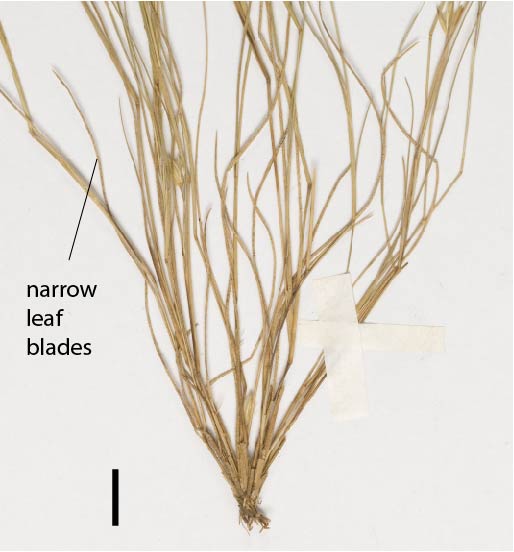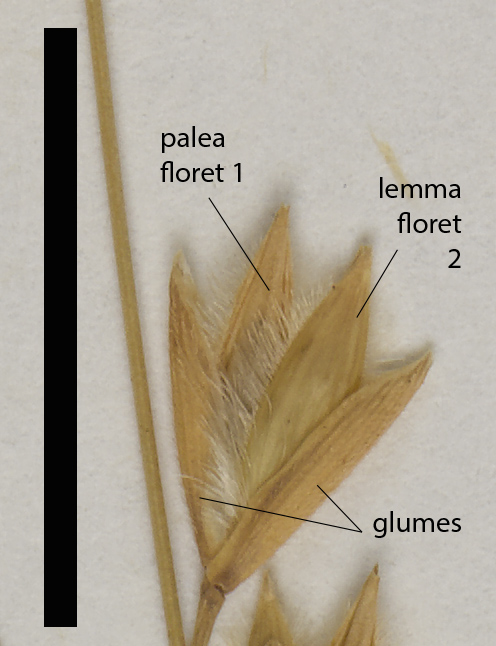Eriachne melicacea
F.Muell.
This species is not commonly recorded from Cape York Peninsula with only a few records from around Laura and one record from Somerset at the tip of the peninsula. It is a slender annual or short-lived perennial 3-45.5 cm high, with branching stems (Fig. 1). Plants are rough to touch with warty based hairs on leaves and stems. Leaves are cauline (arising along the stem) with blades to 10 cm long, the margins rolled inwards giving leaves a fine bristle like appearance (Fig. 2). Inflorescences or flowering branches terminate the stem and appear well exserted some distance from the leaves. The inflorescences or flowering branches are open panicles with branches arising along a central stem, panicles 2.5-5 cm long, 0.5-0.8 cm wide. Eriachne species commonly have spikelets (the basic flowering unit) consisting of two glumes encompassing two bisexual florets (modified flowers) (Fig. 3). In Eriachne melicacea the florets exceed the glumes by 0.3-3 mm, with the lemma of each floret awnless and tapering to a fine point up to 0.6 mm long, the lemma is densely hairy near the base. The palea of each floret is notched or shortly split, the marginal flaps of the palea are fringed with short hairs in the lower part.
Botanical Description
An annual or ephemeral species (3-)13.5-45.5 cm high. The culms scabrous to sparsely hispid with tubercle-based hairs, nodes pilose or glabrous. The leaves are hispid and tuberculate, blade to 10 cm long, bristle like, hispid or scabrous-papillose on upper surface The inflorescence is an open but narrow panicle between 2.5-5 cm long and 0.5-8 cm wide. Spikelets consist of a pair of hairy or hairless glumes 4.8-8.3 mm long and two bisexual florets. The lemma of each floret is between (5.8-) 6.8-7.3 (-9) mm long, exceeding glumes by up to 3 m. The lemma is awnless with a sharp point to 0.6 mm long, grooves are absent and lemma is hirsute near base with long hairs on margins extending almost to the apex. The palea is as long as the lemma or slightly shorter, notched or shortly bifid, sparsely ciliate on margins of flaps at least in lower part.
Diagnostic Features
Eriachne melicacea is not easily confused with other species of Eriachne in the region. It closely resembles E. avenacea but it does not grow in the region and can be distinguished by its awned spikelets. Eriachne melicacea can be identified by the combination of the following characters, fine bristle like leaf blades, florets longer than the glumes and awnless, and the glumes and lemmas purple when young and maturing to yellow or straw coloured.
Natural Values
This species is likely to provide seed for granivorous or seed eating animals.
Habitat
Widespread north of 22°S across northern Australia. Often found on deep or skeletal sandy or loam soils, usually on gravelly rock or stony sites, on laterite, sandstone, quartzite or granite and in seasonally wet sites which including saline environments (Lazarides 2000).
Land Management Notes
Considered generally to be of low forage value (Milson 2000, Lazarides 2002).



Resources
AVH (2017) Australia’s Virtual Herbarium, Council of Heads of Australasian Herbaria, <http://avh.chah.org.au>, accessed 30 May 2017.
Lazarides, M. (1995) The genus Eriachne (Eriachneae, Poaceae). Australian Systematic Botany 8(3): 355-452.
Lazarides, M. (2002) Economic attributes of Australian grasses. Flora of Australia 43: 213-245.
Lazarides, M., Weiller, C.M. & McCusker, A. in Mallett, K. (ed.) (2005) Eriachne. Flora of Australia 44B: 132-175.
Milson, J. (2000) Pasture plants of north-west Queensland. Information Series Q100015. Queensland Department of Primary Industries.
Simon, B.K. & Alfonso, Y. (2011) AusGrass2, http://ausgrass2.myspecies.info/accessed on [20 March 2017].

